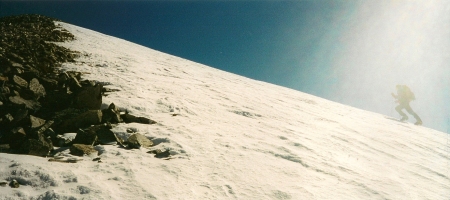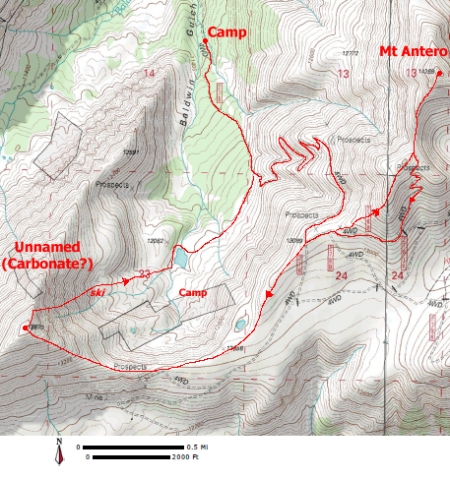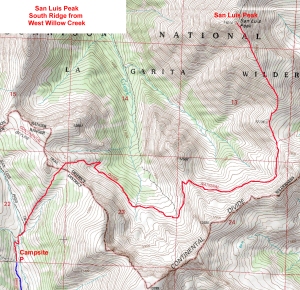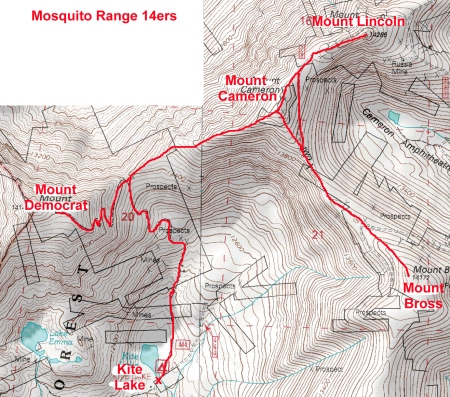“The only way to have a friend is to be one.”
~~Ralph Waldo Emerson
When we play atop the high peak alone, we have only our own interests to consider. It is a simple matter to set a goal and build a plan to accommodate our interests, skills, fitness and tolerance for risk. When we are alone, we can enjoy the high peaks the way we want without any compromise. But it is simply more fun to adventure with people we like and trust. And as an added bonus for team-based adventuring, a collective effort can minimize the risks inherent to playing in a dangerous environment.
But a team is not a group of individuals acting in their own best interest. Members of a “team” demonstrate cooperative and supportive behavior in a common effort to accomplish hard goals. Good team members value a relationship built over time and expressed in mutual understanding, honesty, sympathy, empathy, and loyalty. And, the knowledge of one-another within a team allows complementary abilities and coordinated efforts to generate synergy, which enables a “team” to be greater than the sum of the individuals.
A good team offers safety by being supportive and trustworthy. A bad team doesn’t.
This trip report is about a bad team, of which some of the members successfully summited on Mt. Columbia on May 5, 2000.
Trip Report
On Saturday, May 5th, Brian, Susan (my girlfriend of 4 months and future wife), and I set off from the N. Cottonwood Creek trailhead to climb Mt. Columbia.

Brian (Climbing Partner) and Susan (girlfriend of 4 months) preparing for early start on Mt. Columbia (Colorado)
Brian and I had hiked past the full length of Columbia two years prior when we climbed Mt. Harvard via its South Ridge starting from the N. Cottonwood Creek trailhead; we felt we knew the area well enough to skip a full-on planning effort to climb Columbia’s West Flank and South Ridge. We were right to be confident that the two of us could figure out a way.
But we were wrong to remain confident once we added an inexperienced member to the group.
In the week before the attempt, Susan expressed an interest in joining me on one of my trips. Without thinking, I invited her to join us on the upcoming Mt. Columbia’s climb, and she accepted. If I thought anything, I suppose is was that any difficulties that surpassed her skill set would be at the end of the hike, and so would allow her to simply wait below for a short time if we could not protect her. When I told Brian of the addition to the team, he agreed it would be okay.
We were both wrong in assuming that adding Susan, an inexperienced 14er hiker, to the group would pose no significant problems. But, I would stand alone in blame for the biggest leadership mistake of all.
We drove up Saturday night for a pre-climb car-camp. It would be a long day (Dawson estimate was 11 hours) so we needed a very early start from a trailhead a long way from home. It was a beautiful night for sleeping under the stars, with clear skies and moderate temperatures. We enjoyed a couple hours of camaraderie before turning in for a short night’s sleep.
The next morning we hiked in the pitch dark and soft snow. I had brought snowshoes for Susan, so she was fine; but I had skis, which I put on and took off multiple times as soft snow and exposed rocks competed for my attention. As the trail approached Columbia, snow started to fall and the wind picked up. It was getting cold. But going uphill kept the furnace burning hot, and we continued along following Brian who I assumed knew the way to go.
It was hard to see our destination through the trees, but eventually Brian said we should leave the trail. We turned toward Columbia and made our way closer to the West Flank that looked steeper that I expected. He stopped hiking on a pile of talus under a steep, icy gully and took off his pack. I asked if we were taking a break; Brian said this was it.
I couldn’t believe it! I stared at Brian in disbelieve that he would think this route would work for Susan, and then I looked at Susan. She had a pleasant smile, and was expecting the best of a great day. Oh shit!
I didn’t bring crampons for either of us, and I didn’t bring an ice axe for Susan; and she didn’t know how to use such equipment, anyway.
“What the heck, Brian? Isn’t there an easier way up? Susan can’t climb that!” I communicated to Brian in another glance.
“I think this is it,” was all he said.
We stood there, freezing in the wind, for another moment. Then I told Susan the bad news. She couldn’t continue and it wouldn’t be smart to wait in a cold wind for 5 hours. I told her that it would be best if she went back to the trailhead, where she could get protection from the wind (in my 4Runner), and even catchup on a little sleep.
Susan was agreeable, as always, but she didn’t know the way back. I assured her that it would be easy to simply follow our tracks in the snow, and if she did get lost she could simply listen to find the river, and then she would keep it on her right and follow it back to the bridge crossing to find the trail. I pointed her in the right direction and she left.
Susan adds…
Joe was always going on some adventure or another on the weekends. I thought I’d like to go along, and he said yes. We started hiking so early it was dark, but I just followed behind. We stopped hiking below a very steep snowfield, and Joe said he hadn’t known it was so steep. I was a little upset that I couldn’t finish, but more so that I would have to hike back alone. I was worried about getting lost because I hadn’t paid attention to the trail during the hike in.
Brian put on his crampons and disappeared up the steep, icy gully. I followed by kicking creases in the ice & frozen snow where Brian had weakened it with his steps, and I hauled on trees wherever possible.
Progress up the slope was slow, for obvious reasons.
Once we reached the South Ridge, I hoped we were close so we’d be able to head back soon. But no. We still had a lengthy ridge traverse to reach the summit. And the wind became brutal. With the skis acting as sails, we were tossed around like toys. Brian even took a spill into some rocks after a big gust. But we made it. And, although it was a bit late for snow safety, the cold wind gave us confidence. We hurried back down the South Ridge past our ascent path to reach the a major gully, which probably would have been a better ascent path. (note: the standard ascent path would have been even better; see route photo.)
The ski descent was excellent. The snow was mostly in good shape, except for an unseen slushy spot that initiated a spectacular tumble by me. And rocks were falling from above. But it was a wonderful period of joy that allowed no thoughts of what might have gone wrong for Susan on her retreat.
As we started back, I was surprised at the extent the trail had melted out. It meant we could not ski out very well, and it meant the trail might have been hard to follow. I started wondering about Susan’s fate.
We trudged on and steadily ate up the trail. Shortly after we crossed the creek, we saw Susan hiking toward us. She was delighted to see us as I was delighted to see that she had made it back. I figured she had gotten bored and was coming to meet us.
But I was wrong.
Susan explained that she had not yet made it back to the trailhead. She had been continuously hiking up and down the trails, looking for something that looked familiar. She was actually delighted to see us because finding us meant that she wouldn’t die that day.
Susan adds….
I tried following the tracks, and I nearly made it to the trailhead before getting confused and turning around. I hiked back and forth on the trail for many hours until I found the Joe and Brian heading back. I was so relieved that I wasn’t going to die that I wasn’t even too mad. I had a long day of quality time with myself.
I was amazed that the situation had spun so far out of control. And I was embarrassed. It was entirely my fault, and it forced me to think hard about the proper behaviors for teams with unequally experienced members. Very clearly, I had made two serious errors
- I failed to understand and/or assume responsibility for Susan, who completely trusted me to keep her safe because she could not fully manage her own safety in that situation
- I failed to abandon my personal goal (bag summit of Columbia) when it became incompatible with my responsibility for Susan’s safety
It became clear to me that, for a good team, we need people we know, people we trust not to selfishly, foolishly or ignorantly put us in danger or fail to respond properly to an emergency. And, finding a group of people is just the first step. We then need to turn our “group” into a “team” by continually strengthening relationships and learning about each other in the context of shared adventures that we choose for suitability to the current level of trust and experience among the members. And, most importantly, the experienced members of a team must assume responsibility for the inexperienced members whenever they adventure together, even when it means to give up on the summit to keep a team-member safe.
This must be the first rule of teamwork.
See essays:
And all credit to Susan for finding a happy ending to the story. She stuck with me, after all; our 10-year marriage anniversary is coming up in 2011.

























